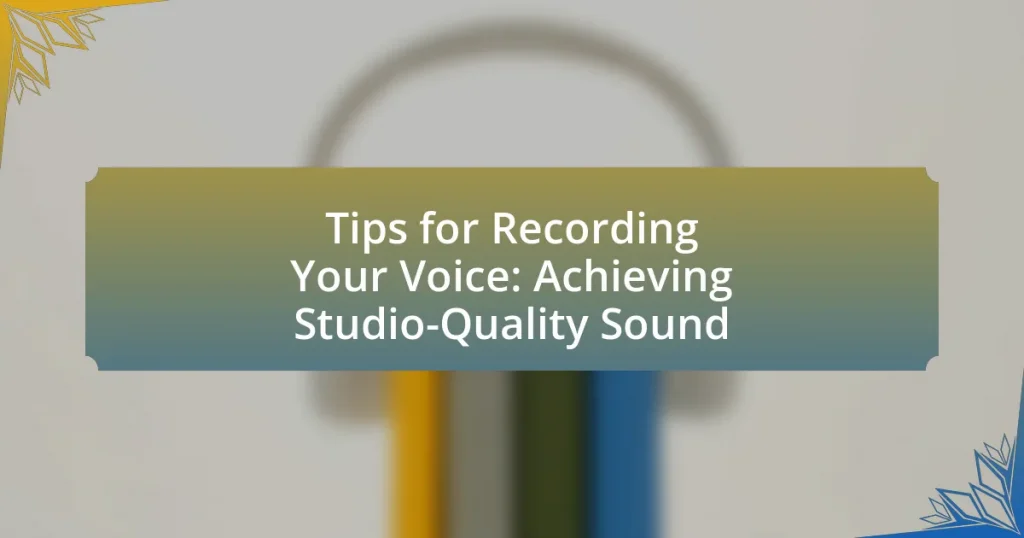The article focuses on essential tips for recording voice to achieve studio-quality sound. It emphasizes the importance of using high-quality microphones, particularly condenser types, and proper microphone placement to capture clear audio. The recording environment is also highlighted, with recommendations for soundproofing and acoustic treatment to minimize background noise and echoes. Additionally, the article discusses optimal recording settings, techniques to enhance vocal performance, and common mistakes to avoid, providing a comprehensive guide for achieving professional-sounding voice recordings.

What are the essential tips for recording your voice to achieve studio-quality sound?
To achieve studio-quality sound when recording your voice, use a high-quality microphone and ensure proper placement. A condenser microphone is often preferred for its sensitivity and clarity. Position the microphone about six to twelve inches from your mouth to capture a balanced sound while minimizing plosive sounds.
Additionally, record in a quiet, acoustically treated space to reduce background noise and echo. Using soundproofing materials, such as foam panels or blankets, can help create a controlled environment.
Finally, utilize a digital audio workstation (DAW) with appropriate settings, including a sample rate of at least 44.1 kHz and a bit depth of 24 bits, to ensure high-resolution audio capture. These practices are supported by audio engineering standards that emphasize the importance of equipment quality and recording environment in achieving professional sound.
How does microphone selection impact voice recording quality?
Microphone selection significantly impacts voice recording quality by determining the clarity, fidelity, and tonal characteristics of the captured sound. Different microphones, such as dynamic, condenser, and ribbon types, have unique frequency responses and sensitivity levels, which affect how accurately they reproduce vocal nuances. For instance, condenser microphones are often preferred for studio recordings due to their wide frequency response and sensitivity, capturing subtle details in the voice that dynamic microphones may miss. Studies show that using a high-quality condenser microphone can enhance vocal recordings by up to 30% in clarity compared to lower-quality options. Therefore, choosing the right microphone is crucial for achieving professional-sounding voice recordings.
What types of microphones are best for voice recording?
Condenser microphones are best for voice recording due to their sensitivity and ability to capture a wide frequency range. These microphones excel in studio environments, providing clear and detailed sound reproduction, which is essential for vocal performances. For instance, the Audio-Technica AT2020 and the Neumann U87 are widely recognized condenser microphones that are favored by professionals for their high-quality audio output. Additionally, dynamic microphones, such as the Shure SM58, are also effective for voice recording, particularly in live settings, as they are more durable and handle high sound pressure levels well.
How does microphone placement affect sound quality?
Microphone placement significantly affects sound quality by influencing the capture of audio characteristics such as clarity, tone, and spatial balance. Proper positioning can enhance the direct sound while minimizing unwanted background noise and reflections. For instance, placing a microphone too close to a sound source can lead to distortion and an exaggerated bass response, known as the proximity effect. Conversely, positioning it too far may result in a loss of detail and presence. Studies have shown that optimal placement, typically within 6 to 12 inches from the source, can yield a more balanced and natural sound, as it captures the intended frequencies without excessive coloration.
What role does the recording environment play in voice recording?
The recording environment significantly impacts voice recording quality by influencing sound clarity and fidelity. Factors such as room acoustics, background noise, and soundproofing determine how well the voice is captured. For instance, a room with hard surfaces can create echoes and reverberations, which distort the voice, while a treated space with sound-absorbing materials minimizes these effects, leading to clearer recordings. Studies show that professional studios often invest in acoustic treatment to optimize sound quality, demonstrating the critical role of the recording environment in achieving studio-quality sound.
How can you optimize your recording space for better sound?
To optimize your recording space for better sound, you should focus on soundproofing and acoustic treatment. Soundproofing involves sealing gaps and using materials that block sound, such as heavy curtains, acoustic panels, or foam, which can reduce external noise interference. Acoustic treatment enhances sound quality by controlling reflections and reverberations within the space; this can be achieved by strategically placing diffusers and absorbers on walls and ceilings. Research indicates that proper acoustic treatment can improve recording clarity by up to 30%, making it essential for achieving studio-quality sound.
What common environmental factors should you consider?
Common environmental factors to consider for achieving studio-quality sound include room acoustics, background noise, and microphone placement. Room acoustics significantly affect sound quality; for instance, hard surfaces can create echoes, while soft furnishings can absorb sound and reduce reverberation. Background noise, such as traffic or electronic devices, can interfere with recordings, making it essential to choose a quiet environment. Additionally, proper microphone placement is crucial; positioning the microphone too close or too far can alter the sound capture, impacting clarity and tone. These factors collectively influence the overall quality of voice recordings.
What techniques can improve your vocal performance during recording?
To improve vocal performance during recording, techniques such as proper warm-ups, breath control exercises, and microphone placement should be employed. Proper warm-ups, including vocal exercises like lip trills and scales, prepare the vocal cords for optimal performance, reducing strain and enhancing sound quality. Breath control exercises, such as diaphragmatic breathing, help maintain vocal stability and power, allowing for sustained notes and dynamic expression. Additionally, correct microphone placement, typically 6 to 12 inches from the mouth, minimizes unwanted noise and captures the voice’s natural resonance, leading to a clearer recording. These techniques are supported by vocal training practices used by professional singers and recording artists, emphasizing their effectiveness in achieving high-quality vocal recordings.
How can warm-up exercises enhance your voice quality?
Warm-up exercises enhance voice quality by preparing the vocal cords and surrounding muscles for optimal performance. These exercises increase blood flow, improve flexibility, and promote relaxation, which collectively contribute to clearer articulation and a more resonant sound. Research indicates that vocal warm-ups can reduce the risk of strain and injury, allowing for sustained vocal use without fatigue. For instance, a study published in the Journal of Voice found that singers who engaged in structured warm-up routines exhibited improved vocal range and stability compared to those who did not.
What are the best practices for microphone technique?
The best practices for microphone technique include maintaining an appropriate distance from the microphone, using a pop filter, and positioning the microphone at an angle to reduce plosive sounds. Keeping a distance of 6 to 12 inches helps capture clear audio while minimizing unwanted noise. A pop filter is essential for reducing plosives, which are explosive sounds that can distort recordings. Additionally, angling the microphone slightly can help in capturing a more balanced sound and reducing harshness. These techniques are widely recognized in audio engineering and are supported by industry standards for achieving high-quality recordings.

How can you ensure high-quality audio during the recording process?
To ensure high-quality audio during the recording process, use a professional-grade microphone and a soundproof environment. A high-quality microphone captures sound accurately, reducing distortion and background noise, while a soundproof environment minimizes external interference, leading to clearer recordings. Studies show that using a condenser microphone in a treated room can improve audio fidelity significantly, as it captures a wider frequency range and provides better sensitivity compared to standard microphones.
What settings should you adjust on your recording equipment?
To achieve studio-quality sound, you should adjust the gain, input levels, and equalization settings on your recording equipment. Proper gain settings ensure that the audio signal is strong enough without distortion, typically aiming for levels around -12 dB to -6 dB on the meter. Input levels should be monitored to avoid clipping, which occurs when the signal exceeds 0 dB. Additionally, equalization can be adjusted to enhance clarity and reduce unwanted frequencies, often involving cutting low frequencies below 80 Hz and boosting mid-range frequencies around 1 kHz to 3 kHz for vocal clarity. These adjustments are essential for producing high-quality recordings that are clear and professional.
How do gain levels affect your recording quality?
Gain levels directly influence recording quality by determining the amplitude of the audio signal captured. Proper gain settings ensure that the signal is strong enough to avoid noise and distortion, while excessively high gain can lead to clipping, which degrades audio fidelity. For instance, recording at a gain level that is too low may result in a weak signal that is susceptible to background noise, whereas an optimal gain level balances clarity and volume, producing a cleaner sound. Studies in audio engineering emphasize that maintaining gain levels within a specific range, typically between -12 dB and -6 dB, maximizes dynamic range and minimizes unwanted artifacts, thereby enhancing overall recording quality.
What sample rates and bit depths are recommended for voice recording?
For voice recording, a sample rate of 44.1 kHz and a bit depth of 24 bits are recommended. This combination provides high-quality audio that captures the nuances of the human voice while maintaining a manageable file size. The 44.1 kHz sample rate is standard for music and voice recording, as it exceeds the Nyquist frequency for human hearing, ensuring accurate reproduction of sound. The 24-bit depth allows for a dynamic range of 144 dB, which is significantly higher than the 16-bit depth used in CDs, thus reducing noise and distortion in recordings.
What software tools can enhance your voice recording experience?
Software tools that can enhance your voice recording experience include digital audio workstations (DAWs) like Audacity, Adobe Audition, and Logic Pro X. These DAWs provide features such as multi-track recording, audio editing, and effects processing, which are essential for achieving high-quality sound. For instance, Audacity is a free, open-source software that allows users to record live audio, edit sound files, and apply various effects, making it accessible for beginners and professionals alike. Adobe Audition offers advanced features like spectral editing and noise reduction, which are crucial for refining voice recordings. Logic Pro X is known for its extensive library of plugins and virtual instruments, enabling users to create professional-grade recordings. These tools collectively contribute to a more polished and studio-like sound in voice recordings.
How can digital audio workstations (DAWs) improve your recordings?
Digital audio workstations (DAWs) can significantly improve your recordings by providing advanced editing, mixing, and mastering capabilities. DAWs enable precise audio manipulation, allowing users to edit tracks with high accuracy, apply effects, and adjust levels seamlessly. For instance, features like non-destructive editing and automation enhance the overall sound quality and creative possibilities. Additionally, DAWs support a wide range of plugins and virtual instruments, which can enrich recordings with professional-grade sounds and effects. Studies show that using DAWs can lead to a more polished final product, as they facilitate a streamlined workflow and enhance the technical aspects of audio production.
What plugins are essential for voice processing?
Essential plugins for voice processing include equalizers, compressors, de-essers, and reverb. Equalizers allow for frequency adjustments to enhance clarity and presence in the voice. Compressors control dynamic range, ensuring consistent volume levels, which is crucial for professional sound. De-essers specifically target and reduce sibilance, preventing harsh sounds from overpowering the recording. Reverb adds depth and space, creating a more natural sound environment. These plugins are widely recognized in audio production for their effectiveness in achieving studio-quality voice recordings.

What are the common mistakes to avoid when recording your voice?
Common mistakes to avoid when recording your voice include poor microphone placement, inadequate room acoustics, and neglecting to perform sound checks. Poor microphone placement can lead to inconsistent audio quality, as positioning too far from the source may result in low volume and increased background noise. Inadequate room acoustics can cause echoes and reverberation, negatively impacting clarity; using soundproofing materials can mitigate this issue. Neglecting sound checks can lead to unbalanced audio levels, making it essential to test equipment and settings before recording to ensure optimal sound quality.
How can improper microphone technique ruin your recordings?
Improper microphone technique can ruin recordings by introducing unwanted noise, distortion, and imbalanced audio levels. When a microphone is positioned too far from the sound source, it captures ambient noise and reduces clarity, leading to a muddy sound. Conversely, placing the microphone too close can cause distortion due to excessive sound pressure levels, resulting in clipping. Additionally, incorrect angles or movements can create phase issues, where sound waves interfere with each other, further degrading audio quality. Studies show that optimal microphone placement can enhance sound fidelity, emphasizing the importance of proper technique in achieving studio-quality recordings.
What are the signs of poor microphone handling?
Signs of poor microphone handling include inconsistent audio levels, excessive background noise, and unwanted pops or distortion. Inconsistent audio levels occur when the microphone is not held at a consistent distance from the sound source, leading to fluctuations in volume. Excessive background noise often results from improper placement or handling, which can pick up unwanted sounds from the environment. Unwanted pops or distortion typically arise from plosive sounds when speaking too close to the microphone without proper pop filters or windshields. These signs indicate a lack of technique in microphone usage, which can significantly affect the overall sound quality in recordings.
How can you avoid plosives and sibilance in your recordings?
To avoid plosives and sibilance in your recordings, use a pop filter and adjust microphone placement. A pop filter, typically made of mesh, diffuses the air from plosive sounds, preventing them from hitting the microphone directly. Additionally, positioning the microphone slightly off-axis from the mouth can reduce the impact of sibilant sounds, which are high-frequency consonants like “s” and “sh.” Studies show that proper microphone technique can significantly enhance audio quality, making these adjustments essential for achieving studio-quality sound.
What pitfalls should you watch out for in your recording environment?
In your recording environment, you should watch out for background noise, poor acoustics, and equipment placement. Background noise can include sounds from traffic, appliances, or other people, which can interfere with the clarity of your recording. Poor acoustics, such as hard surfaces that reflect sound, can create echoes and distortions, negatively impacting audio quality. Additionally, improper equipment placement, such as positioning microphones too close to reflective surfaces or not using pop filters, can lead to unwanted sound artifacts. These factors are critical to achieving studio-quality sound, as they directly affect the fidelity and professionalism of your recordings.
How can background noise affect your voice recordings?
Background noise can significantly degrade the quality of voice recordings by introducing unwanted sounds that interfere with the clarity and intelligibility of the primary audio. This interference can mask important vocal nuances, making it difficult for listeners to understand the spoken content. Studies have shown that recordings made in noisy environments can lead to a decrease in listener comprehension by up to 50%, as background sounds distract from the main audio signal. Additionally, background noise can create challenges during post-production, requiring more time and effort to remove unwanted sounds, which can compromise the overall sound quality.
What are the consequences of poor acoustics in your space?
Poor acoustics in a space lead to significant issues such as distorted sound quality, increased background noise, and difficulty in understanding speech. These consequences hinder effective communication and can negatively impact recording quality, making it challenging to achieve studio-quality sound. Research indicates that spaces with poor acoustics can result in sound reflections and echoes, which disrupt clarity and intelligibility, ultimately affecting the listener’s experience and the overall effectiveness of audio recordings.
What are the best practices for achieving studio-quality sound in your recordings?
To achieve studio-quality sound in recordings, utilize high-quality microphones, proper acoustic treatment, and effective recording techniques. High-quality microphones, such as condenser or dynamic mics, capture a broader frequency range and detail, enhancing sound clarity. Proper acoustic treatment, including soundproofing and using acoustic panels, minimizes unwanted reflections and background noise, creating a controlled environment for recording. Effective recording techniques, such as maintaining optimal mic placement and using pop filters, further improve sound quality by reducing plosives and ensuring a balanced audio capture. These practices are supported by industry standards, which emphasize the importance of equipment quality and recording environment in achieving professional sound.












